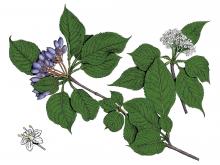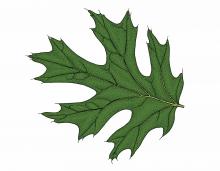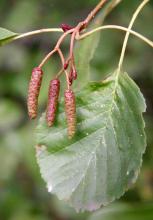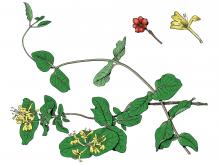Trees, Shrubs and Woody Vines
Media

Species Types
Scientific Name
Cornus drummondii
Description
Rough-leaved dogwood is one of Missouri's hardiest shrubs, capable of withstanding cold and drought. The leaves of this thicket-forming species emit a faint odor of sour milk.
Media

Species Types
Scientific Name
Viburnum lentago
Description
Nannyberry is an understory shrub or small tree that grows in low woods, wooded slopes, and rich valleys near streams. It is officially a Species of Conservation Concern in our state, but its rarity here may be because Missouri is at the southern end of its range.
Media

Species Types
Scientific Name
Quercus velutina
Description
Black oak grows throughout Missouri, in upland woods, on glades, and along borders of woods and fields. It and scarlet oak were the primary colonizers of Ozark pinelands when the native pines were cleared in the early 1900s.
Media

Species Types
Scientific Name
Quercus shumardii
Description
Shumard oak is worth knowing: it can rise to 100 feet in height and gain a trunk diameter of 5 feet, with wide-spreading, muscular boughs.
Media

Species Types
Scientific Name
Quercus palustris
Description
Pin oak is one of the easiest trees to recognize by its shape alone: It has a tall, straight trunk, an overall pyramidal or conical shape and, most notably, the branches on the lower third of the tree angle downward.
Media

Species Types
Scientific Name
Quercus rubra
Description
Northern red oak is a favorite for planting in streets and parks and is one of the most widespread and commercially important of the oaks.
Media

Species Types
Scientific Name
Prunus serotina
Description
Black cherry is prized for its high-quality wood. With its rich red color, it is easy to machine and holds its shape well. Eastern tent caterpillars like black cherry as well, spinning “tents” or bags on the branches for protection while they feed on the leaves.
Media

Species Types
Scientific Name
Alnus glutinosa
Description
Native to Europe and Asia, European, or black alder is planted widely as an ornamental. In some parts of the United States and elsewhere in the world, this species becomes weedy, even invasive. In Missouri, you are most likely to encounter it in landscaped areas, and not in the wild.
Media

Species Types
Scientific Name
Lonicera flava
Description
One of our beautiful, native Missouri honeysuckles, yellow honeysuckle grows mainly in the Ozarks. Unlike the invasive Japanese honeysuckle, this plant is not aggressive and makes a wonderful trellis vine for the ecology-minded gardener.
Media

Species Types
Scientific Name
Lonicera dioica
Description
Limber honeysuckle is a native Missourian. It's uncommon and widely scattered in the state, but it does well as a trellis vine. Identify it by its crowded clusters of tubular, yellow or greenish-yellow flowers, tinged with red, purple, or pink, that are noticeably enlarged on one side at the base.
See Also
About Trees, Shrubs and Woody Vines in Missouri
There are no sharp dividing lines between trees, shrubs, and woody vines, or even between woody and nonwoody plants. “Wood” is a type of tissue made of cellulose and lignin that many plants develop as they mature — whether they are “woody” or not. Trees are woody plants over 13 feet tall with a single trunk. Shrubs are less than 13 feet tall, with multiple stems. Vines require support or else sprawl over the ground.





















